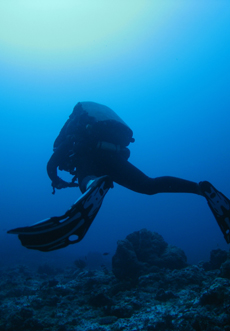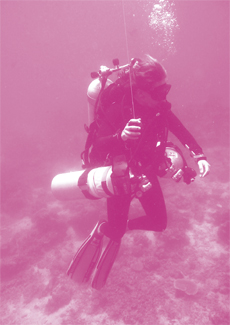




| Home | Features | Club Nights | Underwater Pics | Feedback | Non-Celebrity Diver | Events | 8 August 2025 |
| Blog | Archive | Medical FAQs | Competitions | Travel Offers | The Crew | Contact Us | MDC | LDC |

|

|
 
 |
 |
ISSUE 4 ARCHIVE - TWINSETS, TRIMIX AND THE EVOLUTION: BEING A GIRL TEKKIESophia Butler-CowdryBack in 2001 at the tender age of nineteen, I had qualified as a PADI Divemaster with eighty or so dives on a Coral Cay Conservation project in Honduras, and decided to travel to Indonesia with a friend before starting university. As he was doing his Open Water on the idyllic island of Gili Air, I thought I'd like to try something new too – a decision that would change my life. Blue Marlin Dive suggested I indulge in a nitrox course. Nitrox? I'd only ever heard it mentioned briefly during my DM course, but not discussed it as a real recreational dive option.So there I was, in tropical paradise, with my eccentric French instructor, Didier, going through all the theory – the benefits, the dangers and what it meant in practical terms to dive nitrox. I found it so interesting I couldn't believe no one had suggested it to me before. I just thought everyone would love it and thought it should be seen as a completely normal way to dive more safely, which incidentally is the way it's going now. Didier pointed out the yellow and green labels that are used on nitrox tanks, and constantly emphasised the importance of analysing your own tank before every dive. 'You are the only one responsible for what you breathe,' he would say. This has become one of the most important lessons we should all carry through our tech courses. It is shocking though to still witness apparently competent divers, even at trimix level, nonchalantly disregarding this and diving potentially hazardous mixes without re-analysing on the day of their dive. |
 |

|
Back to my nitrox course, the diving itself was no different,
although I have to say, and I wince at the vain admission even
to myself, I did feel just a little bit cool doing something different
to all the other divers in the water. Despite the extended bottom
time though, I do remember surfacing feeling much clearer
than after an air dive. Whether it's psychological or not, I'm still
not sure, and neither are many of my dive buddies. What is
great though is the fact you can spend most of your dive time
on the best parts of the reef at 30m until nearing low on air
and then slowly work your way to the surface, rather than only
having ten minutes and having to pass more than half your
dive pottering around at 15m or shallower pretending to be
interested in some squirrel fish.
Being one of those people that feels a need to constantly push myself and learn new skills, I decided I needed a real challenge, not just on a physical level, but psychologically too. So, after finishing my Basic Nitrox, I signed up for an IANTD Advanced Nitrox course. Because the twinsets and O2 filling facilities were located at the sister dive shop on Gili Trawangan I was whisked away by speed boat and taken to the infamous party island the next morning. The thought that I might be the only girl on the course didn't put me off – I rather liked the idea, as it gave me a chance to prove myself on equal terms, which being a bit of a tomboy I like to do. What I wasn't prepared for was the overflowing testosterone of the other two students – both strapping lads, Dutch I think, in their early 30s who were definitely wondering what that little nineteen year old English girl was doing there. I believe I crushed any of their prejudices. |
 |
|
The classroom sessions ran similarly to any other course.
I'd done my homework, but there was much more emphasis
on equipment, proper breathing techniques and the fact
there are more inherent risks involved in this type of diving, all
manageable though of course. When it came to equipment
setup there was certainly a lot to get your head around, but
familiarisation is half the battle, so by the time we'd all assembled
and disassembled the kit numerous times to adjust and
readjust, we could do it with our eyes closed. Funnily enough,
we were made to do that in the pool with blacked out masks
– not a disassembly, but having to take off our gear and stages
and put them on again. It does get quite stressful, which is the
point, especially when the instructor moves the stages around
so you are forced to use proper search techniques in the deep
end trying to find them again! The pool sessions were very
intense, but they really hammered home the idea of stress
management and self-reliance.
Carrying the equipment around wasn't the easiest thing in the world, but being a strong swimmer with good upper body strength meant it was doable. I did feel like I couldn't ask for help as much as even the boys did, as I felt any admission of weakness would have stuck in their heads, coming from a girl, and I certainly didn't want that. So, I got round it any way I could – I would lift the twins onto the side of the wash tank, for example, so that I could gear up myself without needing to ask for someone else's help. On the boat was a different matter – the staff would always be keen to get involved with the setup and I loved the pre-dive preparation that is necessary before these dives. They always feel like more of a mission with a greater purpose somehow than a normal recreational dive. I know some readers will say I should dive in cold water more because then every dive would feel like a mission, but I admit, I'm a fair weather diver who loves warm water, but a challenge at the same time – so now that I've found a way to combine both and make it more exciting, I am very satisfied. In the water with twins though, is the best. They make you feel so much more stable, and if you're breathing correctly, then your slow full breath in doesn't affect your buoyancy as much as on a single, which I find particularly annoying normally. The extra weight and bulk force you to have a more streamlined position in the water and so your general dive ability improves enormously. Better trim, more efficient breathing techniques, improved finning and an increased general awareness of what good diving practices are, make technical diving such a positive and fulfilling sport, if you can call it that. The passion had begun – I was addicted. I just wanted to learn more and more, diving twins and planning extended nitrox dives at every opportunity. The following year, in my first uni summer holiday, I did my PADI IDC and crossed over to be an IANTD Advanced Nitrox Instructor at the same time. I dived on twins constantly in any free time between teaching and when my experience was sufficient, I did the Technical Diver course, which meant you could plan deep air dives to 55m, utilising up to two, oxygenrich decompression mixes. I absolutely loved this course and would recommend it to anyone wishing to make deep dives safely. In Indonesia, where most of my tech experience has been built, rather than making bounce dives for the sake of it, you can make extended deep dives on the beautiful, pristine walls where eagle rays come flying past, and where huge schools of jacks and barracuda hang out. |
 | |
|
To cut a long story short, I went back nearly every summer for
three months at a time to keep diving and improve my skills.
I completed the TDI Advanced Trimix course in 2005, which
is my biggest achievement. Hitting 100m for the first time was
probably the most amazing thing I'd ever experienced. The
water was a dark, dark blue but crystal clear and so seductive.
Looking up the wall, you couldn't see the surface but instead,
the stunning sight of branching coral and big fans silhouetted
against the sunlight filtering down through the water. It is a
memory I will never forget and one which I think upon nearly
every day I'm not diving. People often wonder if there's much
down there and yes there is, especially in these tropical waters.
I remember coming across a strange, tree-like, black coral
I think it must be in the sand at the bottom of the wall, and
the most enormous, colourful nudibranchs you can imagine,
nearly a foot in length – out of this world literally.
Subsequently, having made several successful dives in the 100m+ range, the deepest being 114, I felt ready for my final challenge in the autumn of last year – I wanted to be a CCR diver. I had thought about it over the previous couple of years, as you need only be advanced nitrox certified, but I had been rather apprehensive of all the electronics and of a system I thought looked geared towards 'the guys'. I decided to stop being so ridiculous and asked Simon Liddiard, a fabulous tech instructor out in Indonesia and trainer in everything you can think of, if he would teach me on the Evolution – AP Valve's ingenious, closed-circuit rebreather. The training, both theory and practical, was every bit as technically demanding and mentally exhausting as I'd imagined. It was a matter of getting to grips with what the figures on the handset really meant, and frequent monitoring of it, to then be able to enjoy perfect buoyancy and the most peaceful diving imaginable. I found myself totally lost in my own thoughts, mesmerised by the aquatic world around me and saw diving in a whole new light. It truly is an awesome experience but definitely the most challenging and unforgiving course of my dive career. You must fully, and absolutely, understand the theoretical and practical rules and limits of rebreather diving, undertake continual analysis of the information at hand, and be mentally prepared for any eventuality. Technical diving opened up so many doors for me on a personal level; I learned to really trust and believe in myself redefining my limits. Learning to analyse and manage risk in potentially dangerous environments requires a certain maturity of thought and responsibility I never thought I was capable of, especially at my age. But, in so doing, I've made some truly awesome dives and experienced so many things I never thought possible, in a world that few are privileged enough to ever know. I just wonder where the next challenge will lead... If you're interested, you can check out my progress at talazia.com. |
 | |
Previous article « The Lusitania Chronicles Next article » Whale Watching Back to Issue 4 Index | ||